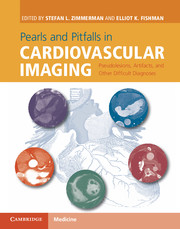 Pearls and Pitfalls in Cardiovascular Imaging
Pearls and Pitfalls in Cardiovascular Imaging from Section 4 - Coronary arteries
Published online by Cambridge University Press: 05 June 2015
Imaging description
Streak, or beam hardening, related either to highly concentrated intravenous contrast or to metal from devices within the superior vena cava/right atrium, may result in artifacts that overlap the course of the right coronary artery (RCA) and limit accurate evalution at coronary CT. These artifacts may be either high attenuation or low attenuation in appearance (Figures 30.1 and 30.2). They are often linearor starburst-shaped in appearance. They are recognized by their origin from a region of highly concentrated, hyper-attenuating contrast material or a metallic device in an adjacent right-sided cardiac structure.
Importance
Streak artifact can limit diagnostic quality of coronary CT examinations. In some cases, diagnostic visualization of the RCA may be impossible. In other cases, streak artifacts may simulate stenoses or calcification, leading to misdiagnosis and potentially inappropriate treatment or therapies.
Typical clinical scenario
Right coronary artery streak artifact can occur when highly concentrated intravenous contrast has not cleared the superior vena cava or right atrium at the time of the coronary CT acquisition. Dual-bolus or triple-bolus injection techniques use a saline flush that is designed to push the contrast out of the right cardiac structures and eliminate streak artifact. In the dual-bolus technique, contrast is followed by a saline flush that is intended to clear the right-sided cardiac structures of any contrast. The disadvantage of this technique is that qualitative and quantitative assessment of the right ventricle is limited due to lack of contrast in the RV cavity. In the triplebolus technique, also known as split-bolus, the initial injection of contrast is followed by a mix of contrast and saline, then finished with a pure saline flush. The objective is to fill left-sided structures (left atrium and ventricle, coronaries, aorta) with high-attenuation contrast, fill right-sided structures with a moderate amount of dilute contrast to allow better visualization, and to clear the superior vena cava of high-attenuation contrast to avoid streak.
To save this book to your Kindle, first ensure no-reply@cambridge.org is added to your Approved Personal Document E-mail List under your Personal Document Settings on the Manage Your Content and Devices page of your Amazon account. Then enter the ‘name’ part of your Kindle email address below. Find out more about saving to your Kindle.
Note you can select to save to either the @free.kindle.com or @kindle.com variations. ‘@free.kindle.com’ emails are free but can only be saved to your device when it is connected to wi-fi. ‘@kindle.com’ emails can be delivered even when you are not connected to wi-fi, but note that service fees apply.
Find out more about the Kindle Personal Document Service.
To save content items to your account, please confirm that you agree to abide by our usage policies. If this is the first time you use this feature, you will be asked to authorise Cambridge Core to connect with your account. Find out more about saving content to Dropbox.
To save content items to your account, please confirm that you agree to abide by our usage policies. If this is the first time you use this feature, you will be asked to authorise Cambridge Core to connect with your account. Find out more about saving content to Google Drive.